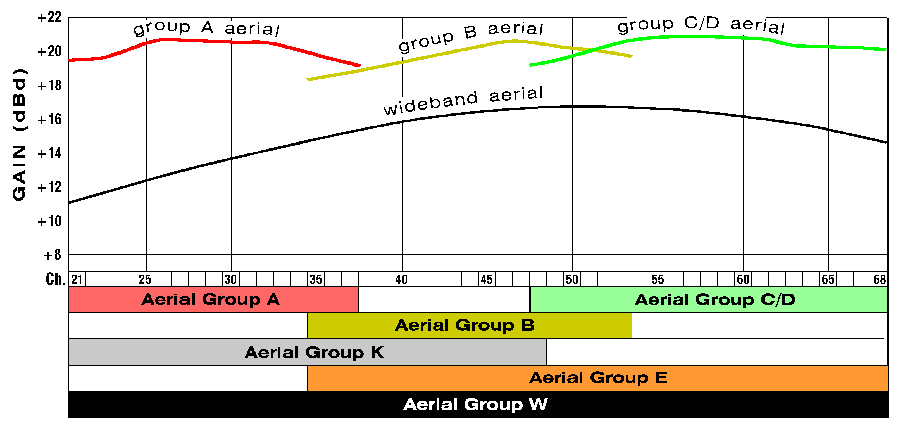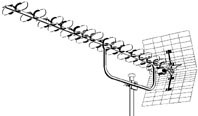Early in 2006 I was quoted €450 for the provision and installation of a TV aerial to my house.
I thought this was outrageous for essentially putting a bit of wire mesh on the roof, so I decided
to learn a little and to do it myself. Here are my findings:
I am one of the 15% of the population that can receive UK channels through terrestrial TV,
and in Longford (and the surrounding counties of Cavan, Monaghan, Leitrim, Roscommon and Westmeath),
one can receive 112MHz of info over 14 UHF channels, from 2 transmitters:
signal gain as an aerial designed for a narrower band of frequencies.  Generally a transmitter will transmit in a narrow band of frequencies so that people
Generally a transmitter will transmit in a narrow band of frequencies so that people
in an area can get an aerial better tuned to those frequencies
which both gives a better picture and better ignores transmissions from any neighbouring transmitters.
The one I want given the table above is group A as it does UHF channels 21-37.
Note I'm biasing towards the Brougher Mountain transmitter as that
is the farthest away and has the most content (that I'm interested in at least).
The Cairn Hill transmitter is only 5 miles away and is the most powerful in Ireland (at 800kW)
while the Brougher Mountain transmitter is about 60 miles away and only 100kW,
so I am able to pick up the Cairn Hill transmissions even with a group A aerial.
I suppose one could combine a group K aerial and group A aerial if farther away
from Cairn Hill than I. Group K is designed for UHF channels 22-50 and so should also
give the Brougher Mountain transmissions a bit of a boost.
I went for the Hirschmann FESA 817 N 37 which is the best group A aerial apparently, and
I was able to source this and all other components (pole, brackets, ...) locally in Crossans in Longford town.
So how to mount the aerial? Note both transmitters above transmit in the horizontal plane,
so we need the aerial in the same plane. I.E. the elements should be horizontal as can be seen
in the picture below. Also you point the small end at the transmitter, so the transmitter
is to the left of the picture below.

(slightly higher is required for UHF channels above group A (Band IV)),
while for UHF DTT it is 32dBuV (45dBuV is recommended).
Even though we require much less signal to receive the DTT stations, Brougher Mountain
transmits all DTT stations at just 500W (to protect RTÉ services in Donegal),
which is 23dB lower than the analogue channels' power.
Now DTT is designed to support transmission at 20dB lower, so reception is problematic.
In summary I can't receive MUX2 on my PVR, but the others are fine.
Following is a table with the signal strengths reported by my PVR, which shows that
I can probably tweak things to get all MUXes over the reception threshold (60% on this PVR at least).
Note it suggests here that the power will be increased in 2011?
As for digital broadcasts from Cairn Hill, I'll probably be waiting until the EU deadline of 2012.
Note transmitters in Dublin and Louth will start trialling DTT in August 2006.
[Update Sep 4th 2019: HD channels are no longer being received reliably due to the 700MHz clearance done to make place for mobile data. Consequently the BBCB mux containing the HD channels has changed from channel 25 to 37. Now type A aerials cater for channels 21-37, but as 37 is at the end of the aerial band, the signal falls below an acceptable threshold (which can be inferred from the older signal strength progression in the table above). Reception is better on cloudy days, and the equivalent SD channels are received fine.]
[Update Apr 17th 2024: I've removed the aerial due to aesthetic reasons, including not being a bird perch which results in a dirty roof. Actually I retained the smaller aerial for the saorview muxes, and moved it into my attic (under natural slate). This is fine to receive UHF channels 44 and 47 from the 160kW transmitter, 14Km away. Terrestrial TV continues to decline both in signal and content quality, while internet connectivity continues to improve. Therefore we now use chromecasts running the iBox service to access the main Irish and UK terrestrial channels.]
I thought this was outrageous for essentially putting a bit of wire mesh on the roof, so I decided
to learn a little and to do it myself. Here are my findings:
I am one of the 15% of the population that can receive UK channels through terrestrial TV,
and in Longford (and the surrounding counties of Cavan, Monaghan, Leitrim, Roscommon and Westmeath),
one can receive 112MHz of info over 14 UHF channels, from 2 transmitters:
| Brougher Mountain | ||
| UHF channel | Channel | Sub Channels |
| 22 | BBC1 | |
| 23 | MUXA | five, discovery, television x, BBC radio 4, ... |
| 25 | ITV1 | |
| 26 | MUXB | BBC4, CBeebies, ... |
| 28 | BBC2 | |
| 29 | MUXC | Sky three, Sky news, E4+1, UKTV History... |
| 30 | MUX1 | BBC3, BBC News 24, ... |
| 32 | CH4 | |
| 33 | MUXD | ftn, Film4, The Hits, BBC world service, ... |
| 34 | MUX2 | ITV[1-4], Channel 4, More 4, ... |
| Cairn Hill | ||
| UHF channel | Channel | Sub Channels |
| 40 | RTE1 | |
| 43 | NET2 | |
| 46 | TV3 | |
| 50 | TG4 | |
Which Aerial?
A wideband aerial that can cater for all 49 UHF channels allocated to TV, will not have as goodsignal gain as an aerial designed for a narrower band of frequencies.

in an area can get an aerial better tuned to those frequencies
which both gives a better picture and better ignores transmissions from any neighbouring transmitters.
The one I want given the table above is group A as it does UHF channels 21-37.
Note I'm biasing towards the Brougher Mountain transmitter as that
is the farthest away and has the most content (that I'm interested in at least).
The Cairn Hill transmitter is only 5 miles away and is the most powerful in Ireland (at 800kW)
while the Brougher Mountain transmitter is about 60 miles away and only 100kW,
so I am able to pick up the Cairn Hill transmissions even with a group A aerial.
I suppose one could combine a group K aerial and group A aerial if farther away
from Cairn Hill than I. Group K is designed for UHF channels 22-50 and so should also
give the Brougher Mountain transmissions a bit of a boost.
I went for the Hirschmann FESA 817 N 37 which is the best group A aerial apparently, and
I was able to source this and all other components (pole, brackets, ...) locally in Crossans in Longford town.
So how to mount the aerial? Note both transmitters above transmit in the horizontal plane,
so we need the aerial in the same plane. I.E. the elements should be horizontal as can be seen
in the picture below. Also you point the small end at the transmitter, so the transmitter
is to the left of the picture below.

DTT (DVB-T) (Freeview) reception
The minimum required reception power for UHF Analogue TV is 58dBuV(slightly higher is required for UHF channels above group A (Band IV)),
while for UHF DTT it is 32dBuV (45dBuV is recommended).
Even though we require much less signal to receive the DTT stations, Brougher Mountain
transmits all DTT stations at just 500W (to protect RTÉ services in Donegal),
which is 23dB lower than the analogue channels' power.
Now DTT is designed to support transmission at 20dB lower, so reception is problematic.
In summary I can't receive MUX2 on my PVR, but the others are fine.
Following is a table with the signal strengths reported by my PVR, which shows that
I can probably tweak things to get all MUXes over the reception threshold (60% on this PVR at least).
Note it suggests here that the power will be increased in 2011?
| UHF channel | MUX | Signal strength% | Modulation |
| 23 | A | 63 | 64QAM |
| 26 | B | 60 | 16QAM |
| 29 | C | 58 | 16QAM |
| 30 | 1 | 58 | 16QAM |
| 33 | D | 55 | 16QAM |
| 34 | 2 | 51 | 64QAM |
As for digital broadcasts from Cairn Hill, I'll probably be waiting until the EU deadline of 2012.
Note transmitters in Dublin and Louth will start trialling DTT in August 2006.
[Update Sep 4th 2019: HD channels are no longer being received reliably due to the 700MHz clearance done to make place for mobile data. Consequently the BBCB mux containing the HD channels has changed from channel 25 to 37. Now type A aerials cater for channels 21-37, but as 37 is at the end of the aerial band, the signal falls below an acceptable threshold (which can be inferred from the older signal strength progression in the table above). Reception is better on cloudy days, and the equivalent SD channels are received fine.]
[Update Apr 17th 2024: I've removed the aerial due to aesthetic reasons, including not being a bird perch which results in a dirty roof. Actually I retained the smaller aerial for the saorview muxes, and moved it into my attic (under natural slate). This is fine to receive UHF channels 44 and 47 from the 160kW transmitter, 14Km away. Terrestrial TV continues to decline both in signal and content quality, while internet connectivity continues to improve. Therefore we now use chromecasts running the iBox service to access the main Irish and UK terrestrial channels.]
© May 23 2006